Voter ID laws in the United States mandate that individuals present specific identification when voting, with requirements varying widely by state. These laws can create barriers that disproportionately affect marginalized groups, potentially leading to lower voter turnout and raising legal concerns about their constitutionality and fairness in the electoral process.
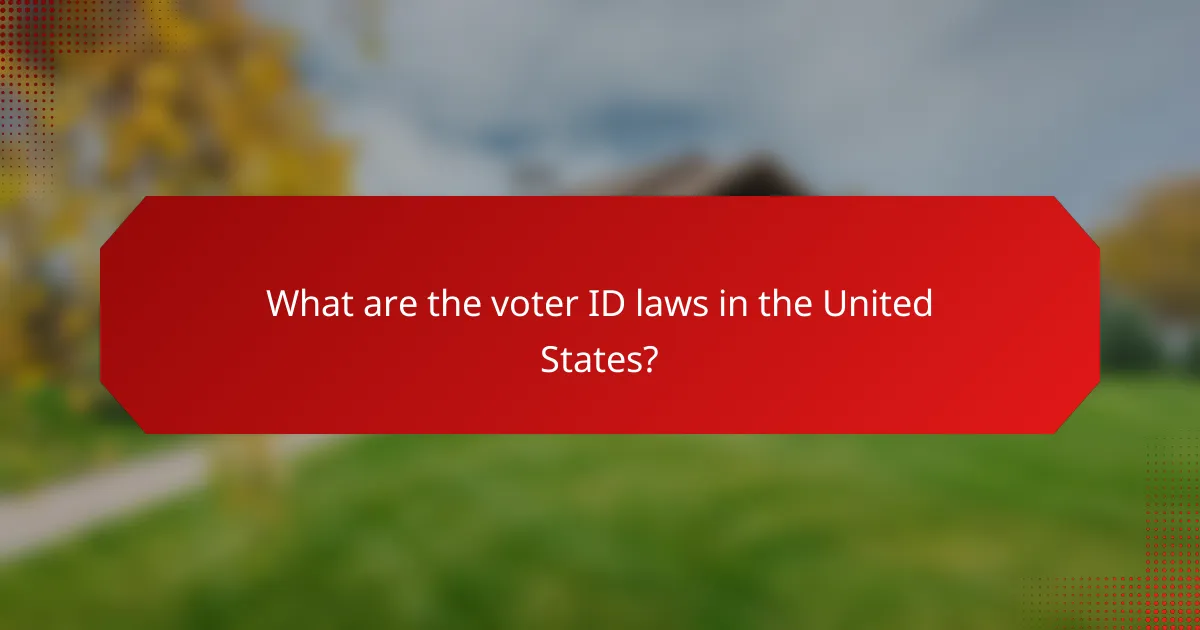
What are the voter ID laws in the United States?
Voter ID laws in the United States require individuals to present specific forms of identification when voting. These laws vary significantly by state, influencing the types of IDs accepted and the processes for obtaining them.
State-specific requirements
Each state has its own voter ID requirements, which can range from strict to lenient. Some states mandate a photo ID, while others accept non-photo identification or do not require any ID at all. For instance, states like Georgia and Indiana have strict photo ID laws, whereas states like California and New York do not require ID for most voters.
It is essential for voters to check their state’s specific regulations before an election, as failure to comply can result in being unable to vote. Many state election offices provide resources online to help voters understand what is needed.
Types of acceptable identification
Acceptable forms of identification can include government-issued photo IDs, such as driver’s licenses, passports, or military IDs. Some states may also accept student IDs or utility bills with a name and address as valid forms of identification.
Voters should ensure that their ID is current and matches the name on their voter registration. In some states, voters may be allowed to cast a provisional ballot if they do not have the required ID, but they must provide the necessary identification within a specified timeframe for their vote to count.
Variations by election type
Voter ID requirements can differ based on the type of election, such as general elections, primaries, or local elections. Some states may impose stricter ID requirements for federal elections compared to local ones.
Additionally, certain states may have different rules for first-time voters or voters who registered by mail. It’s crucial for voters to be aware of these variations to ensure they meet the necessary identification requirements for each election type.
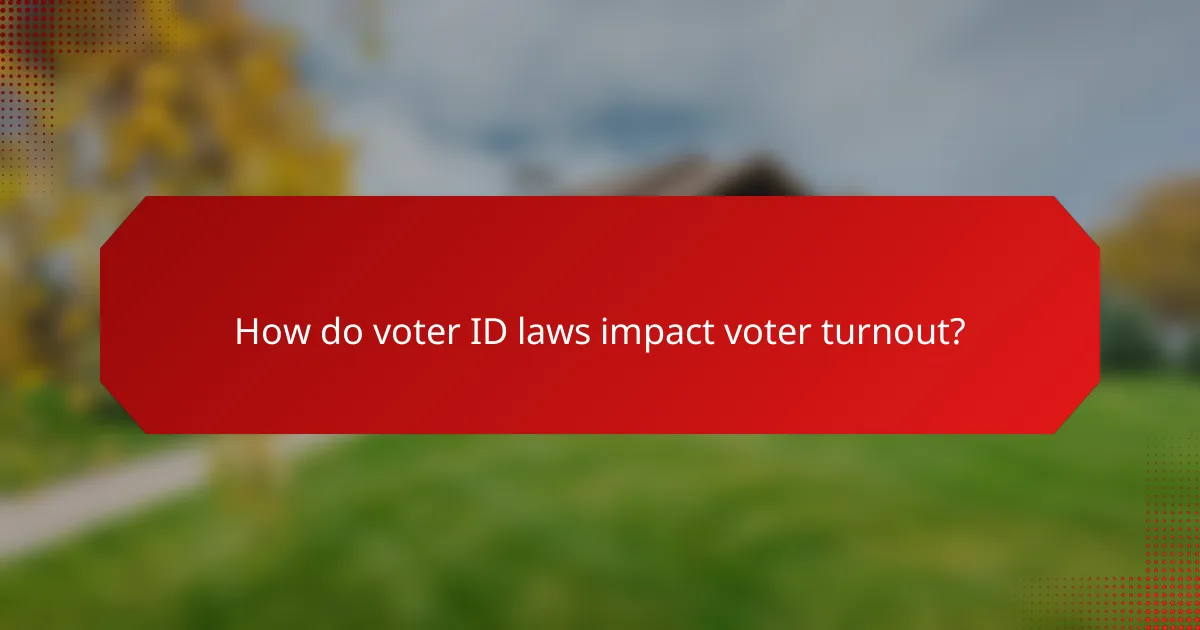
How do voter ID laws impact voter turnout?
Voter ID laws can significantly affect voter turnout by creating barriers for individuals who may lack the required identification. These laws often lead to lower participation rates, particularly among marginalized groups who may face challenges in obtaining valid IDs.
Studies on voter participation
Research indicates that states with strict voter ID laws tend to experience a decrease in voter turnout compared to those with more lenient requirements. Studies have shown that turnout can drop by several percentage points, particularly in elections with high stakes. This decline is often attributed to confusion over ID requirements and the difficulty some voters face in acquiring the necessary identification.
For example, a study conducted in the United States found that states implementing strict ID laws saw turnout among minority voters decrease by up to 10%. This suggests that while the intention of these laws may be to enhance election security, they can inadvertently disenfranchise eligible voters.
Demographic effects
Voter ID laws disproportionately impact certain demographic groups, including low-income individuals, racial minorities, and the elderly. These populations are more likely to lack the required forms of identification, which can lead to significant disparities in voter participation rates. For instance, a survey revealed that minority voters are often less likely to possess government-issued IDs compared to their white counterparts.
Additionally, younger voters and those with lower educational attainment may also struggle with the complexities of obtaining valid identification. As a result, voter ID laws can exacerbate existing inequalities in the electoral process, making it crucial for policymakers to consider these implications when designing identification requirements.
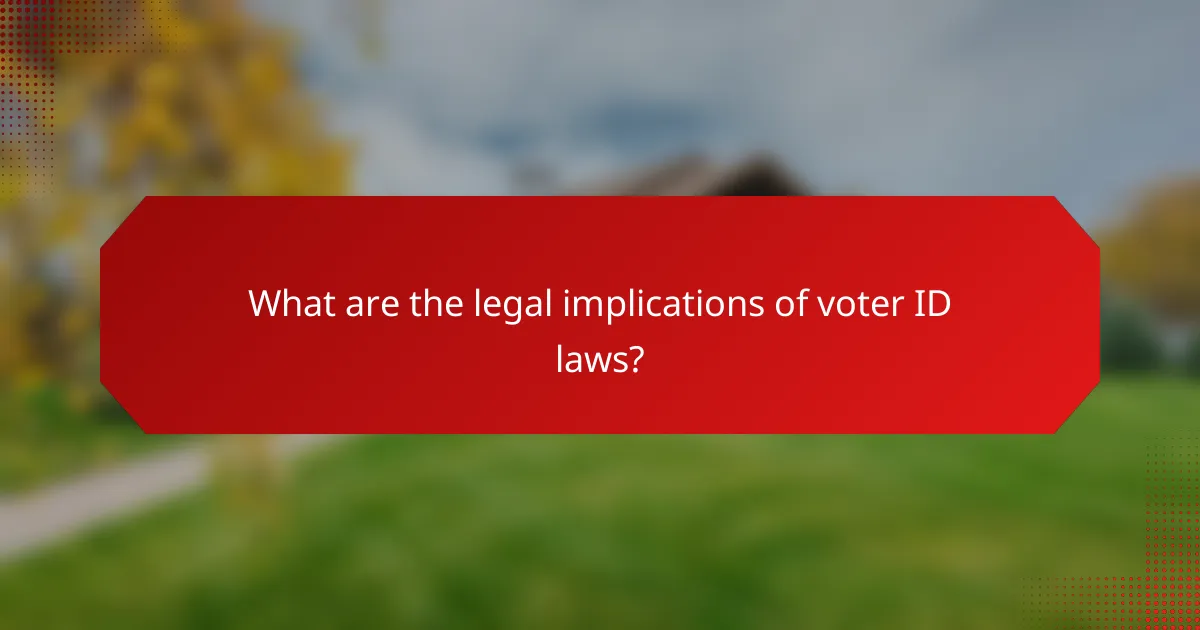
What are the legal implications of voter ID laws?
Voter ID laws can significantly impact the electoral process by establishing requirements for identification that voters must meet to cast their ballots. These laws raise legal questions regarding their constitutionality and potential discrimination against certain groups of voters.
Constitutional challenges
Voter ID laws often face constitutional challenges based on claims that they violate the Voting Rights Act or the Equal Protection Clause of the Fourteenth Amendment. Critics argue that these laws disproportionately affect minority voters, the elderly, and low-income individuals who may lack the required identification.
Legal battles frequently focus on whether the state has a compelling interest in enforcing ID requirements and if the laws are narrowly tailored to achieve that interest without disenfranchising voters. Courts may assess the burden imposed on voters against the state’s justification for the law.
Recent court rulings
Recent court rulings on voter ID laws have varied widely across different jurisdictions. Some courts have upheld strict ID requirements, citing the need to prevent voter fraud, while others have struck down laws that they deemed overly burdensome or discriminatory.
For instance, several states have seen courts rule against voter ID laws after finding that they disproportionately impacted specific demographic groups. These rulings underscore the ongoing legal debate surrounding the balance between election integrity and voter access.

How can voters comply with ID requirements?
Voters can comply with ID requirements by obtaining an acceptable form of identification that meets their state’s regulations. This often involves applying for a government-issued ID or ensuring their existing ID is valid for voting purposes.
Steps to obtain valid ID
To obtain a valid ID, start by checking your state’s specific ID requirements, as they can vary significantly. Most states require a photo ID, which can include a driver’s license, state ID, or passport. If you do not have any of these, you may need to visit a local government office to apply for a state-issued ID.
Gather necessary documents such as proof of identity, residency, and, in some cases, citizenship. Common documents include a birth certificate, Social Security card, or utility bill. Once you have the required documents, visit the appropriate agency, complete the application, and pay any associated fees, which can range from free to around $30 depending on the state.
Resources for assistance
Various resources are available to help voters navigate ID requirements. The National Association of Secretaries of State offers a website where you can find information specific to your state’s voting ID laws. Additionally, local election offices can provide guidance on obtaining IDs and understanding what forms are acceptable.
Nonprofit organizations often assist with voter ID issues, offering help with applications and even transportation to ID-issuing offices. Check with local civic groups or voter advocacy organizations for support and resources tailored to your community.
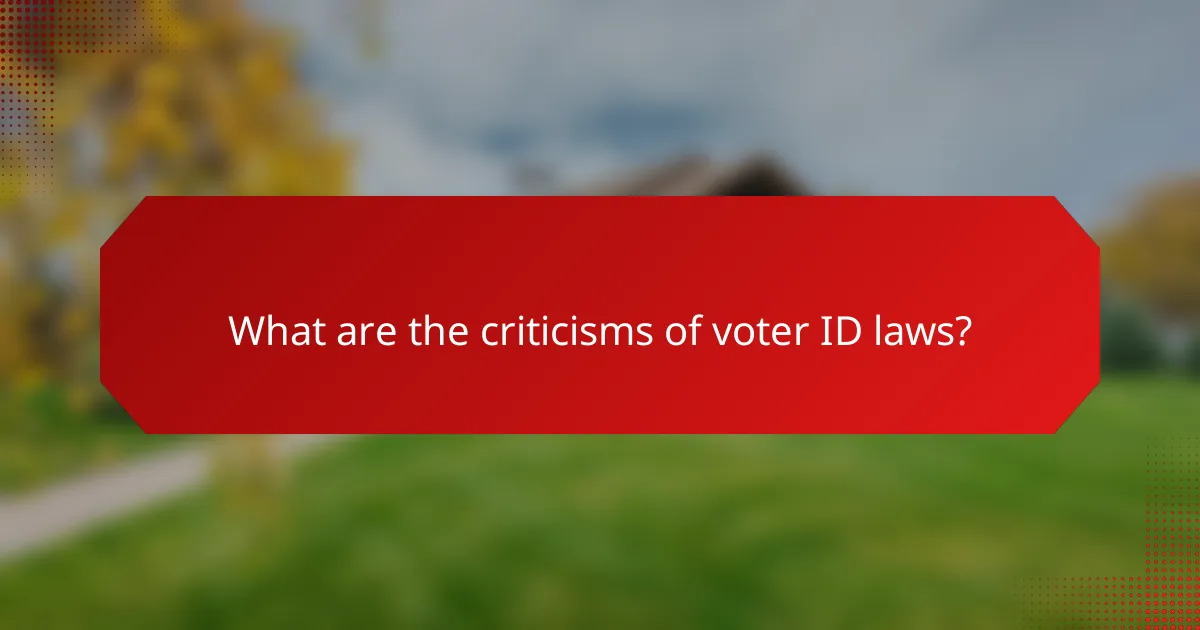
What are the criticisms of voter ID laws?
Critics of voter ID laws argue that these regulations can disproportionately affect certain groups of people, leading to disenfranchisement. They contend that the requirements for identification create unnecessary barriers to voting, undermining the democratic process.
Claims of disenfranchisement
One of the primary criticisms of voter ID laws is that they can disenfranchise eligible voters, particularly among minority groups, the elderly, and low-income individuals. Many in these demographics may lack the required forms of identification, which can lead to reduced voter turnout.
Studies have shown that states with strict voter ID laws often see a decline in participation rates among these vulnerable populations. For example, some reports indicate that voter turnout can drop by several percentage points in areas where such laws are enforced.
Arguments against necessity
Opponents of voter ID laws argue that the incidence of voter fraud is extremely low, making strict identification requirements unnecessary. Research has consistently shown that cases of impersonation at the polls are rare, often cited as being in the low tens of cases per election cycle.
Furthermore, many believe that the focus should be on improving voter access rather than imposing additional barriers. Alternatives such as same-day registration and automatic voter registration are often proposed as more effective means to enhance electoral participation without the drawbacks associated with ID laws.

What are the differences in voter ID laws across states?
Voter ID laws vary significantly across the United States, with some states requiring strict identification while others have more lenient requirements or none at all. Understanding these differences is crucial for voters to ensure compliance and avoid issues at the polls.
Comparison of strict vs. non-strict states
Strict states mandate that voters present specific forms of identification to cast their ballots, often including government-issued photo IDs. If a voter cannot provide the required ID, they may be denied the ability to vote or may have to cast a provisional ballot that requires further verification.
Non-strict states, on the other hand, may allow voters to provide alternative forms of identification or may not require ID at all. In these states, voters can often verify their identity through other means, such as signing an affidavit or providing personal information. This flexibility can help increase voter participation.
Examples of states with unique laws
Texas is an example of a strict voter ID state, requiring voters to present one of several specific photo IDs, such as a driver’s license or a military ID. Failure to present an acceptable ID can lead to complications in the voting process.
In contrast, California operates under non-strict laws, where voters are not required to show ID at the polls. However, if a voter is registering for the first time and did not provide ID during registration, they may need to show some form of identification. This distinction highlights the diverse approaches states take regarding voter identification.

How do voter ID laws affect minority groups?
Voter ID laws can disproportionately impact minority groups by creating barriers to voting. These laws often require specific forms of identification that some individuals, particularly those in marginalized communities, may not possess or find difficult to obtain.
Impact on racial and ethnic minorities
Racial and ethnic minorities frequently face challenges in meeting voter ID requirements due to socioeconomic factors. Many may lack access to the necessary documents, such as birth certificates or government-issued IDs, which can be costly or time-consuming to acquire. This can lead to lower voter turnout among these groups.
Additionally, the enforcement of voter ID laws can create an atmosphere of intimidation, further discouraging participation. Minority voters may feel targeted or unfairly scrutinized, which can exacerbate feelings of disenfranchisement.
Case studies and statistics
Several studies have shown that states with strict voter ID laws experience a notable decline in voter turnout among minority populations. For example, research indicates that minority voter turnout can drop by double-digit percentages in states implementing stringent ID requirements.
In a specific case, a study in a Southern state revealed that Black voters were significantly less likely to possess the required ID compared to their white counterparts. This disparity highlights the systemic issues that voter ID laws can perpetuate, reinforcing existing inequalities in the electoral process.
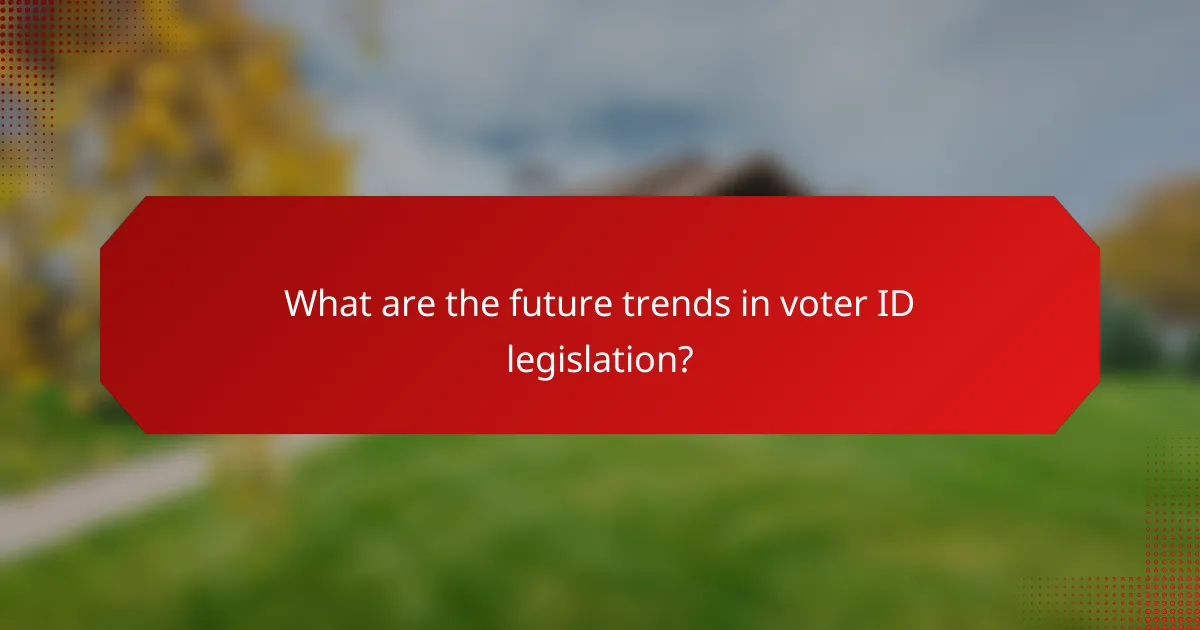
What are the future trends in voter ID legislation?
Future trends in voter ID legislation are likely to focus on balancing security and accessibility. As states continue to implement or revise ID requirements, the emphasis will be on ensuring that laws do not disenfranchise eligible voters while addressing concerns about election integrity.
Increased adoption of technology
Many jurisdictions are exploring the use of technology to streamline voter ID processes. This includes digital IDs and biometric verification methods, which can enhance security while making it easier for voters to comply with ID requirements.
For example, some states may implement mobile applications that allow voters to securely store and present their identification. This trend could simplify the verification process and reduce the burden on voters who may have difficulty obtaining traditional forms of ID.
Legal challenges and court rulings
As voter ID laws evolve, legal challenges are expected to continue. Courts will likely scrutinize new legislation to ensure it complies with constitutional protections and does not disproportionately impact specific groups of voters.
Recent rulings have shown that courts may strike down laws perceived as overly restrictive. This ongoing legal landscape will shape how states approach voter ID requirements, potentially leading to more inclusive policies.
Focus on voter education and outreach
With changing voter ID laws, there will be a growing emphasis on educating the public about identification requirements. States may implement outreach programs to inform voters about what forms of ID are acceptable and how to obtain them.
Effective voter education can help mitigate confusion and ensure that eligible voters are prepared to meet ID requirements. This could include informational campaigns through social media, community organizations, and local government initiatives.
